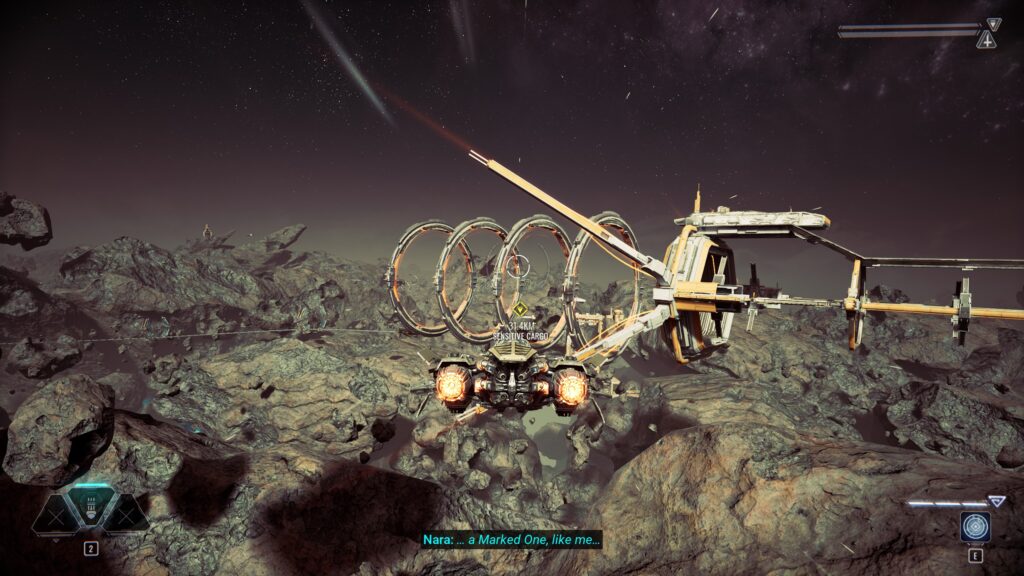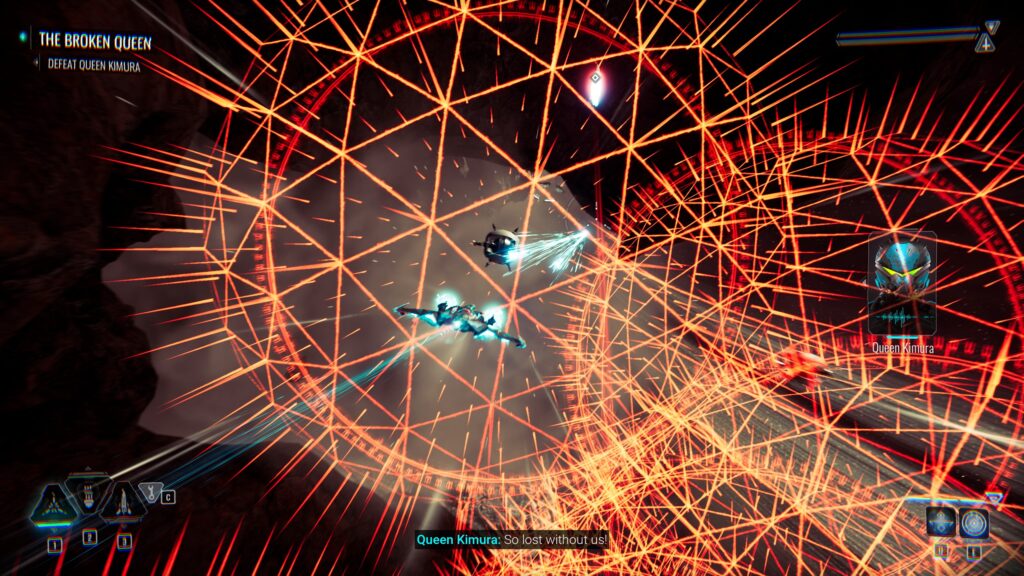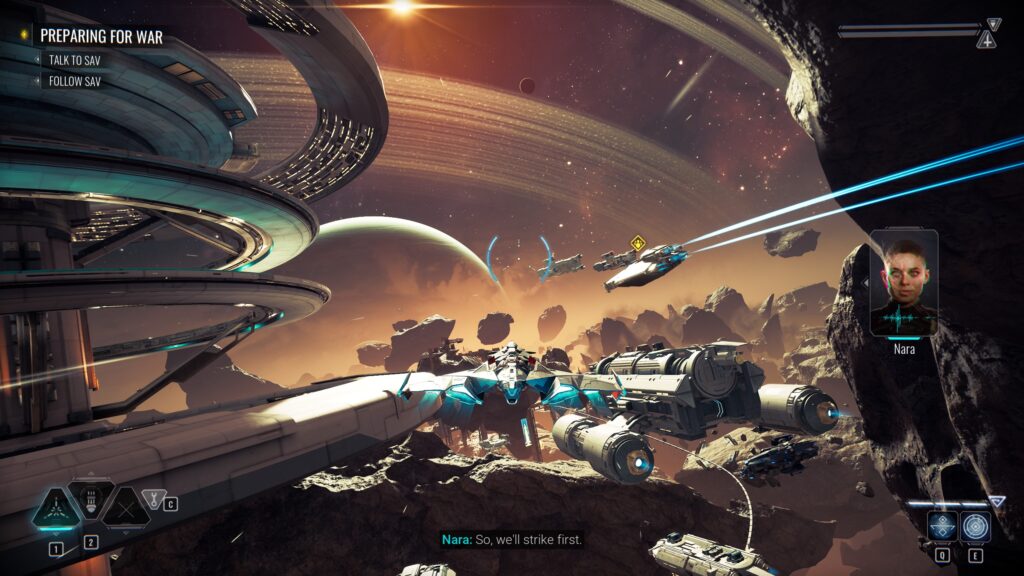
This reminded me of the old Descent video game from back in the day, the earliest game that offered true 3D combat in a spaceship. It was incredibly easy to get lost in the labyrinthine corridors and could be a nauseating experience. Chorus is much more forgiving as it mostly takes place in wide, open areas and has a very simplified control system that even occasionally corrects your rotation by itself. I’ve found that an old-fashioned mouse and keyboard system works better than a gamepad and there’s no question of trying to use a joystick. While it doesn’t have a realistic flight model, it excels in making you feel like an awesome starfighter pilot standing alone against an entire enemy fleet. It’s very lore-heavy but the story isn’t too bad at all and I’d say the game is just about the right length.
The galaxy faces a growing threat in the form of a cult called the Circle. Though it started as a spiritual movement with the intention of uniting the universe into a state of perfect harmony, their leader the Great Prophet became increasingly deranged and corrupt after coming into contact with the extradimensional Faceless entities, turning the cult into a all conquering, militaristic force. Nara was once the Circle’s greatest warrior but after destroying an entire planet, turned away from the cult and fled. Now the Circle has arrived at even the most remote reaches of the galaxy and threatens the Enclave where Nara now works as a scavenger. Nara must retrieve her sentient ship Forsa that she abandoned when she left the Circle and reawaken her psychic powers to defeat them. Along the way, she must confront the truth of what she did and face her own fears and doubts in order to achieve and even surpass the previous heights of her powers and rally the galaxy against her former masters.

As a space combat game with some light RPG elements, you’re constrained entirely to the cockpit of your spacecraft. There are cutscenes which involve Nara getting out and walking around but that’s it. This conceit gets a little strained at times when the game demands that you to run around talking to people and activate switches as if you were on foot. But in action, this is probably one of the best implementations of starfighter combat I’ve ever encountered. Your ship is small and somewhat fragile but it more than makes up for it by being incredibly, indeed impossibly, maneuverable. It has the ability to near-instantaneously do 180 degree turns and easily hence outflies any enemy. It has three different weapons systems, guns, lasers and missiles, which are each best suited to different types of enemy defenses and you can further modify the ship with modules.
You will however need to face off against entire fleets of enemy fighters, elite units with special abilities such as being invulnerable from frontal attacks and eventually even capital ships. For the largest ships, you need to whittle down their individual components, destroying their turrets and their shield generators to expose the vulnerable core inside them. The odds seem insurmountable but Nara gains psychic powers, called Rites, that even them. The Rite of the Storm for example instantly drops all shields on the target and temporarily stuns it. Another rite teleports you directly behind an enemy. You’re limited by the energy required to use these powers but you keep upgrading your powers throughout the game such that by the end you can effortlessly crush entire fleets. I’ve never played a Star Wars game that allowed the use of the Force from inside a starfighter but this is exactly what that would feel like.

The result is space combat that feels fluid and is immensely satisfying. Your ship’s unparalleled ability to turn to face any direction at any time ensures that there are never any turning duels or jousting situations. You’ll always be able to keep your weapons pointed at the enemy so the only question is how many enemies can you take down in a single pass? Capital ships look intimidating at first but once you understand their layout, it’s a cinch to fly into and through to take out their components. The game wants you to use your powers all the time. Having trouble keeping up with a fast moving enemy? Why bother with complex maneuvers when you can just teleport right behind them every once in a while? Sometimes the powers even feel too powerful as they obviate the need for special tactics. Even the most heavily shielded enemies are vulnerable to a single application of the Rite of the Storm.
That said, the game is still plenty challenging, though not always for good reasons. As I’ve said, to take down the capital ship you need to destroy its components but that requires you to first learn where they are across the ship. During story missions, you are required to fulfill objectives according to some fixed order and it can be difficult to figure what it is you’re meant to do in the chaos of battle. For example, you might be told to eliminate enemies but you’re really supposed to destroy some key enemies as the chaff fighters will keep respawning endlessly until you do. For the most part, the checkpoints for the long story missions are quite generous. But there are some boss fights which can get extremely frustrating because of how much you’d need to replay if you die during a fight. There are plenty of complaints in Reddit and other spaces where people complain about giving up on the game due to these difficulty spikes.

I rather liked the story about Nara turning against the cult to make up for her past complicity. The writing in general is quite good and I loved the quieter voice of Nara’s conscience talking back to her and undermining everything she says. Forsa too is a complete character in his own right and the story addresses the relationship between the two in an interesting way. That said, players are justified too in complaining that there is too much lore. The mystical aspects Nara’s powers are emphasized too much and keep repeating the same themes of achieving harmony, the so-called Chorus. Meanwhile there’s no real effort at world building. Who is building the ships used by the Circle? How were the worlds governed before the Circle conquered everything? It’s great that Nara’s powers allow her to relive the memories of others to reveal their backstories but it would have been nice to know a little too about the galaxy they all live in.
All told, playing this was a fantastic experience and I loved its original take on starfighter combat. There are a few niggles here and there, there’s way too much repetition in the randomly generated side missions and the reward in the form of credits is meaningless. There’s no real use for them in the game at all. Plus they needed to make it a little more obvious what they expect the player to do during the long story missions. But in terms of presentation and most of all gameplay this was just great. Unfortunately it failed to make enough money so there probably won’t be any sequels. But I do hope that it will inspire copy cat games that attempt to go further with its mechanics.